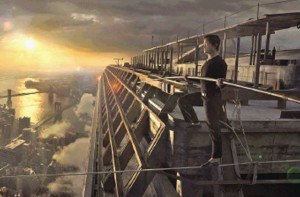
DIRECTED by Robert Zemeckis, “The Walk” is about French aerialist Philippe Petit’s high-wire walk between the Twin Towers of the World Trade Center in 1974. At the time, one of the towers had been partially occupied while the other was still being completed.
Petit (played by Joseph Gordon-Levitt), guided by his real-life mentor, Papa Rudy (Ben Kingsley), is aided by an unlikely band of international recruits, who overcome long odds, betrayals, dissension and countless close calls to conceive and execute their mad plan.
“I love the idea of a guy—a performance artist—who pulls off this great caper,” Zemeckis said. “The caper is illegal, it’s dangerous, but it doesn’t hurt anybody. It seemed like something out of another time—you don’t really see stuff like that anymore. It was almost like a fable.”
When Zemeckis first heard this story, he thought that the film should be presented in 3D.
“When you watch a wire walker, you always have to watch by looking up at him, he said. “You never get the perspective of what’s it like to be on the wire. Our film will follow Petit’s story but will ultimately put you on the wire, walking with Philippe, and by presenting it in 3D, it is going to be spectacular and very emotional.”
In the film, Zemeckis has Petit himself narrate moments during his feat to add insight—especially to his inner thoughts on the wire. The slightly surreal use of the Statue of Liberty device for this helps lend a fable-like quality to the PG-rated film.
“This is a true story down to all its details, but it also has a ‘once upon a time’ feel to it—a lost time and place-and I wanted to combine the literal with the figurative,” Zemeckis said.
The project was especially intriguing for Visual Effects Supervisor Kevin Baillie because of the immense challenge it presented: the entire world of 1974 New York, as seen from thousands of feet in the air, between two buildings that have since fallen, would have to be created from scratch.
“We have to make everything, from the lobby of the World Trade Center to 1974 downtown New York City,” Baillie said. “The production design department actually built on a giant stage the roof of one of the towers. It was a mind-blowingly cool, big set, but the city around it, the fog swirling between the towers, the towers themselves rising up from the city, all had to be created completely digitally, based on photo references. Those buildings obviously don’t exist anymore, sadly, but they had to feel absolutely, 1,000 percent real and present, because they are the emotional heart of the film.”
Of course, the film would not have been possible without the real Philippe Petit, who says that the film is a highly accurate portrayal of his real-life coup.
“The Walk” opens in theaters on Oct. 14.